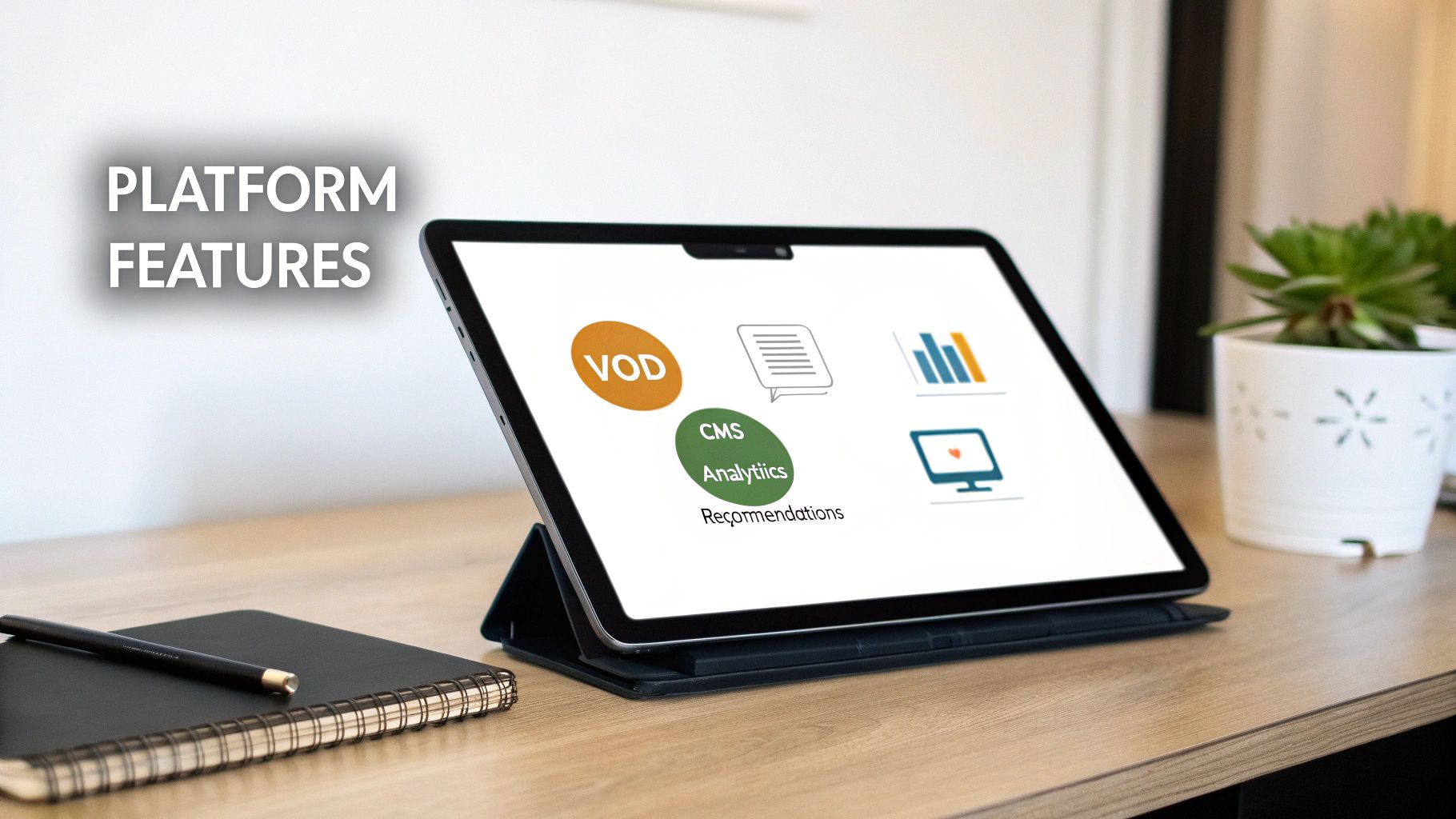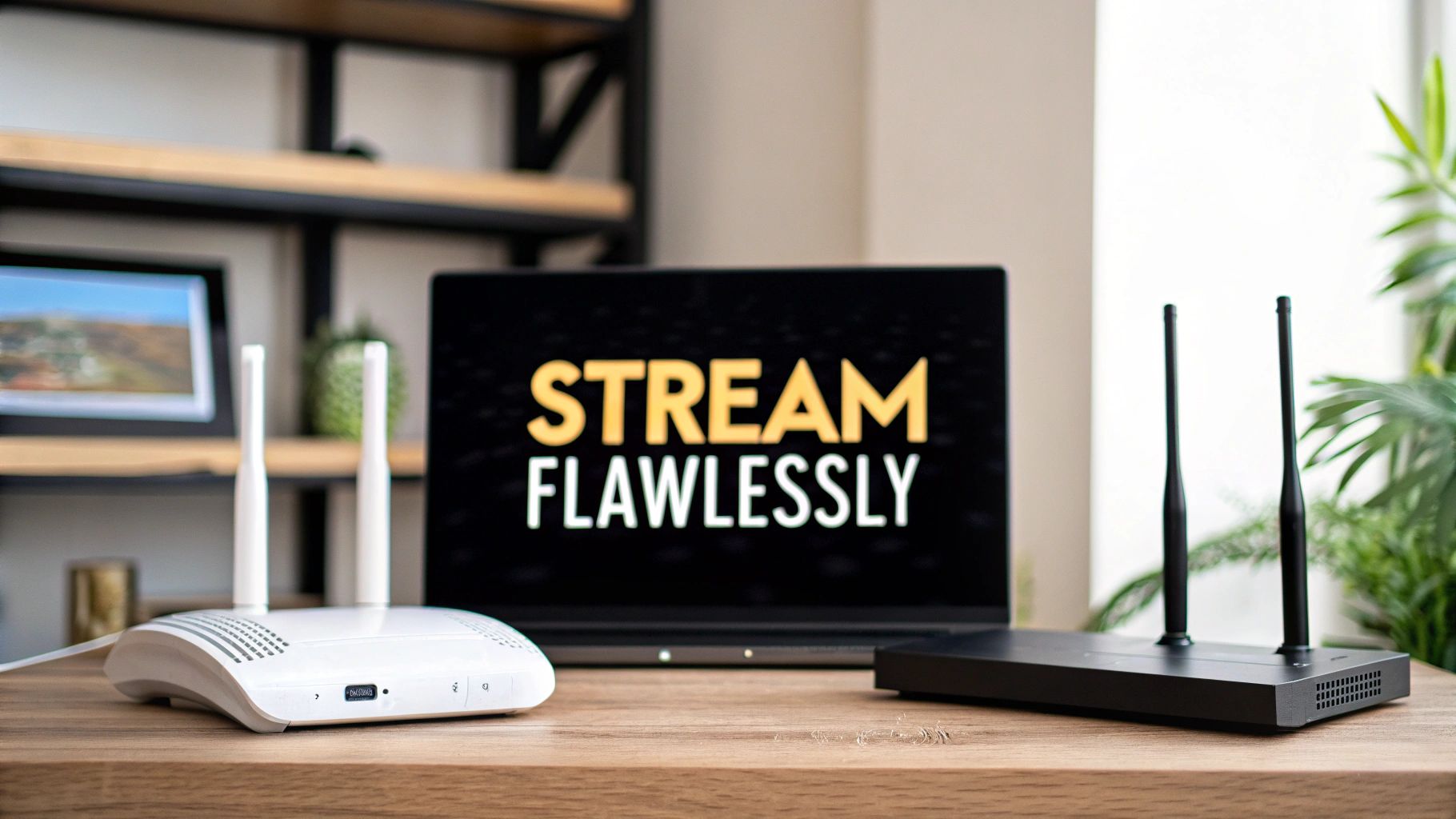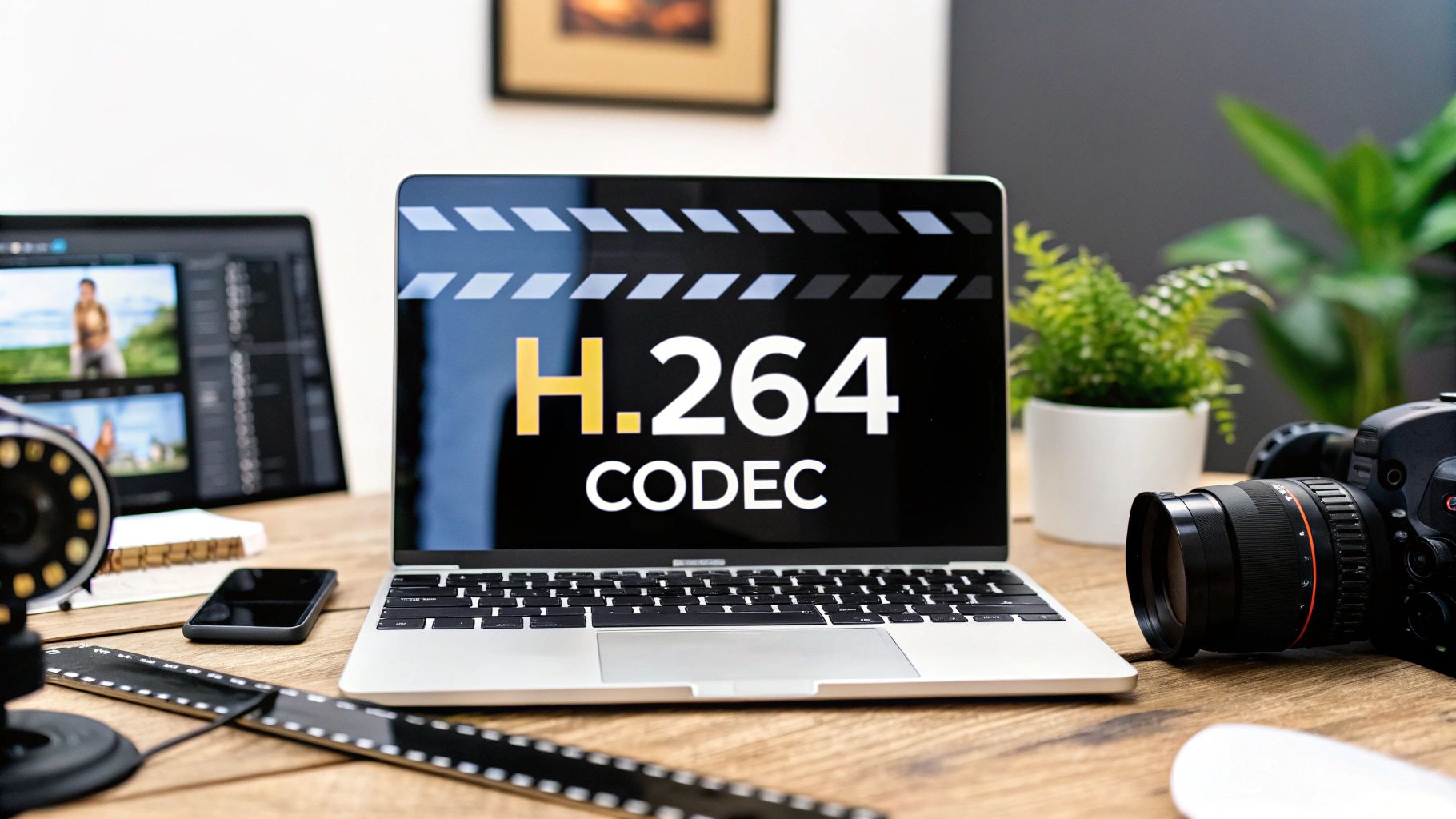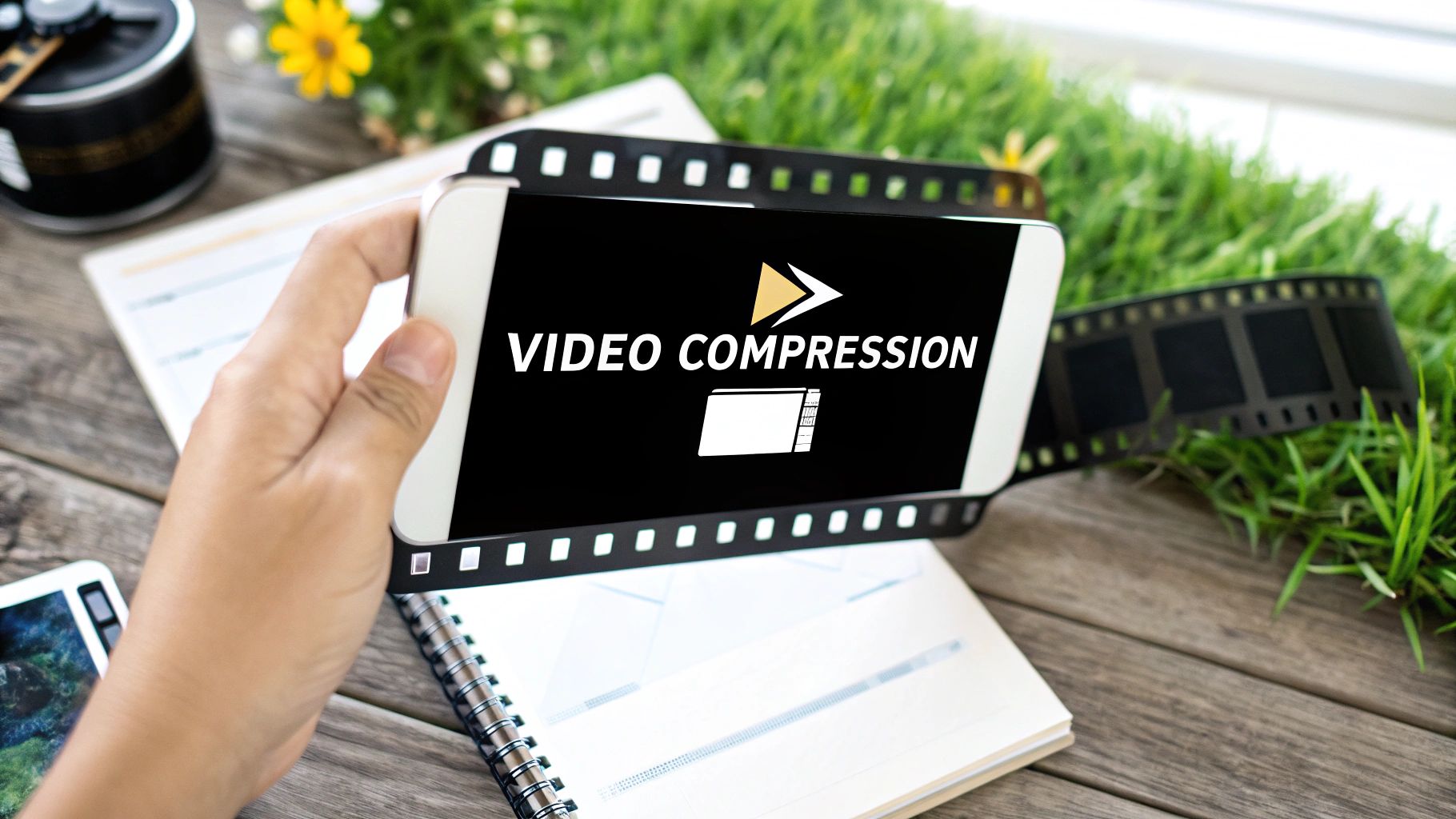Video on demand platforms are the reason you can binge-watch an entire season of your favorite show in a single weekend. They are, in essence, digital libraries that let you watch what you want, when you want, completely untethered from a traditional broadcast schedule.
This model hasn’t just tweaked how we watch TV; it has completely revolutionized it. Today, an incredible 85% of people worldwide are streaming content every single day.
Understanding Video on Demand
Think of it like this: remember when you had to plan your evening around a TV schedule? Video on demand blew that concept apart. A VOD platform is like a massive, always-open video store where you can instantly play anything from its collection. No showtimes, no waiting. You’re in complete control.
This shift from appointment viewing to instant access is now the standard for media consumption. It’s all powered by a few core business models, each with its own way of connecting content with an audience.
The Three Pillars of VOD
Chances are, you’ve used all three of these models without even thinking about it. They are the foundation of the entire VOD world.
- Subscription VOD (SVOD): This is the all-you-can-eat buffet. You pay a flat fee—usually monthly or yearly—for unlimited access to a massive library of content. Netflix and Disney+ are the titans of this model. It’s great for predictable revenue, but the constant pressure is on to keep adding fresh content so subscribers don’t get bored and leave.
- Ad-Supported VOD (AVOD): This is the “free” model, monetized by commercials. Viewers don’t pay a dime, but they watch ads before, during, or after their content. Think of YouTube or Pluto TV. The goal here is to attract a huge audience, making it an appealing platform for advertisers to spend their money on.
- Transactional VOD (TVOD): This is the classic pay-per-view approach. You can either “rent” a movie for a short period or “buy” it to own forever. It’s perfect for brand-new blockbuster releases on platforms like Apple TV or when you purchase a season of a show on Amazon Prime Video. This model works best for high-demand, premium content that people are willing to pay for directly.
The Technology Powering Modern VOD
Ever wonder how a massive 4K movie file gets from a server halfway across the world to your screen in just a few seconds, without a single stutter? It’s not magic. It’s a clever combination of three core technologies working together to make modern video on demand platforms possible. Getting a handle on these concepts is the first step to understanding how a seamless viewing experience is built.
The process kicks off the moment a video is finished. A raw, uncompressed video file is a monster—way too big to send over a typical internet connection. That’s where the first piece of the puzzle, video encoding, comes in.
Shrinking Files Without Losing Quality
Think of video encoding as a digital vacuum sealer. It takes that huge video file and intelligently compresses it by removing unnecessary data, making it much smaller and easier to manage. It’s like zipping a folder full of photos before emailing it.
But encoding, or transcoding as it’s also called, does more than just create one smaller file. It actually generates a whole set of video files at different quality levels and resolutions. This collection is often called a “rendition ladder,” and it’s crucial for delivering a smooth stream later on.
Delivering Content at Lightning Speed
Okay, so the video files are a manageable size. Now, how do we get them to viewers all over the world without a massive delay? Sending everything from one central server would be a nightmare for anyone living far away. This is where a Content Delivery Network (CDN) is an absolute game-changer.
A CDN is basically a huge network of servers spread out across the globe. Picture a global coffee chain. Instead of everyone having to fly to the original roastery in Seattle for a cup, there’s a local shop in your city ready to serve you instantly. A CDN does the same thing for video files.
This infographic gives a simple visual of how content gets from a central library to your screen.

CDNs are the backbone of VOD. By caching (or storing) copies of videos on servers closer to where people are actually watching, they slash latency—that annoying delay between hitting play and the video starting. It’s the reason you can start watching instantly, whether you’re in New York or Tokyo. If you want to get deeper into the mechanics, you can learn more about how a CDN for video streaming works and why it’s so important.
Adapting to Every Connection
We have our compressed video files and a global network to deliver them. But what about a shaky internet connection? This is where the final, and arguably most brilliant, piece of the puzzle comes in: Adaptive Bitrate Streaming (ABR).
ABR is the unsung hero that prevents buffering. Think of it like a smart suspension system in a car that instantly adjusts to a bumpy road. Your video player is constantly checking your internet speed and network conditions.
Key Takeaway: Adaptive Bitrate Streaming is the magic behind buffer-free viewing. It dynamically switches between different video quality files based on a viewer’s real-time internet connection.
If your connection is solid, the player pulls down a beautiful, high-quality video from that rendition ladder we talked about. The moment you walk into a room with weak Wi-Fi, the player detects the drop and seamlessly switches to a lower-quality version. You might see the resolution dip for a second, but the video never stops.
This smart, on-the-fly adjustment is fundamental to how every major video on demand platform works. It guarantees that every viewer gets the best possible picture their connection can support at that very moment. Together, encoding, CDNs, and ABR are the powerful trio that make instant, high-quality streaming a reality.
How VOD Platforms Make Money
So, you’ve got amazing content and the tech to deliver it. That’s a great start, but it’s only two-thirds of the puzzle for any successful video on demand platform. The third piece—and maybe the most important—is a solid business model. How you choose to make money will shape everything, from the content you license to the experience your viewers have.
This isn’t a small-time game, either. The entire video on demand market was valued at a staggering $154.55 billion in 2024, and it’s on track to hit nearly $281.85 billion by 2032. That massive growth is fueled by a few core ways platforms turn viewers into revenue. You can dig deeper into the numbers and discover more insights about VOD industry growth in this detailed market analysis.
The All-You-Can-Eat Buffet: Subscription VOD (SVOD)
Subscription Video on Demand, or SVOD, is what most people think of when they hear “streaming.” It’s essentially a gym membership for content. Viewers pay a set fee—usually monthly or yearly—and get unlimited access to everything in the library.
This model is the engine behind giants like Netflix, Hulu, and Disney+. It gives them a predictable, stable stream of revenue, which is great for planning and budgeting. The flip side? Customer churn. Keeping people from hitting that “cancel” button is a constant battle, forcing these platforms to pour money into a relentless stream of new, exclusive shows and movies.
Key Insight: In the SVOD world, you have to prove your worth every single month. A stale content library is the quickest way to send your subscribers running to a competitor.
Free for All: Advertising VOD (AVOD)
Advertising-Based Video on Demand (AVOD) turns the subscription model on its head. Instead of asking viewers to open their wallets, these platforms give away their content for free. The money comes from selling ad space, just like old-school broadcast television.
Services like YouTube, Pluto TV, and Tubi have mastered this approach. Their goal is simple: get as many eyeballs as possible. The low barrier to entry is a huge plus, allowing them to build massive audiences. But this model isn’t without its risks—revenue can swing wildly with the ad market, and you have to be careful not to annoy viewers with too many commercials.
- Benefit: Great for attracting a huge audience, including people who would never pay for a subscription.
- Challenge: Revenue is less predictable and depends entirely on ad spending and viewership numbers.
- Best For: Platforms with content that has broad, mass-market appeal.
Pay-Per-View Reimagined: Transactional VOD (TVOD)
Transactional Video on Demand (TVOD) is the modern-day equivalent of the neighborhood video rental store. Viewers pay for one specific piece of content at a time, either as a temporary rental or a permanent “digital purchase.”
You see this every time you rent a new blockbuster on Apple TV or buy a full season of your favorite show on Amazon Prime Video. TVOD shines when it comes to high-demand, premium events like new movie releases or big-ticket sports. While you can earn more per viewer on a single transaction, the income is far less predictable than a subscription, since it hinges on someone making an active choice to buy each and every time.
Choosing the right monetization strategy is critical. To make it clearer, here’s a breakdown of how these three primary models stack up against each other.
Comparison of VOD Monetization Models
| Model | How It Works | Primary Benefit | Key Challenge | Best For |
|---|---|---|---|---|
| SVOD | Users pay a recurring fee (e.g., monthly) for unlimited access to a content library. | Predictable, stable revenue stream. | High content costs and constant pressure to prevent customer churn. | Platforms with a large, diverse library of exclusive or original content. |
| AVOD | Content is offered for free, with revenue generated from selling ad space. | Low barrier to entry for viewers, enabling massive audience growth. | Revenue is variable and dependent on ad market fluctuations. | Broad-appeal content and platforms aiming for maximum reach. |
| TVOD | Users pay a one-time fee to rent or purchase a single piece of content. | Higher revenue per transaction for premium content. | Unpredictable revenue stream that relies on individual purchase decisions. | New movie releases, live sporting events, and niche, high-value content. |
Each model has its own distinct rhythm and set of rules, catering to different types of content and consumer behaviors.
The Rise of Hybrid Models
In today’s crowded market, many video on demand platforms are realizing they don’t have to pick just one lane. Hybrid models are becoming the new norm, blending elements from two or more strategies to hit different audiences. For example, Hulu famously offers a cheaper plan with ads (SVOD + AVOD) alongside its pricier, ad-free option.
This kind of flexibility is smart. It allows platforms to attract price-sensitive viewers who don’t mind a few commercials, while still capturing premium revenue from those who demand an uninterrupted experience. By mixing and matching, platforms build a more resilient business that isn’t dangerously dependent on a single source of income.
Weaving Live Streaming into Your VOD Platform
A deep library of on-demand content is a great starting point, but the real magic in viewer engagement today is happening in real-time. The best video on demand platforms are no longer just digital archives; they’re transforming into dynamic hubs that pair pre-recorded content with the electric energy of a live broadcast. This blend creates a far more compelling experience than static VOD can offer on its own.
The pull of live video is its immediacy. Think about the Super Bowl, a breaking news event, or a surprise album drop. These moments tap into a collective “fear of missing out,” drawing massive audiences who all want to watch at the exact same time. It fosters a powerful sense of community, even when people are watching from their own couches.

And this isn’t just a niche trend; it’s a seismic shift in how we consume media. The live streaming market is a global powerhouse, valued somewhere between $99–$100 billion in 2024. To put that in perspective, that’s a fourfold jump in just five years. The growth isn’t slowing down, either, with projections showing the market could hit $345 billion by 2030. You can get a closer look at these staggering numbers and discover more insights about the live streaming market on Teleprompter.com.
Why a Hybrid Approach Is a Game-Changer
Marrying live and on-demand content creates a virtuous cycle. A live event draws in a huge crowd right away. Once the stream ends, you can add the recording to your VOD library, turning a one-time event into a long-lasting asset that keeps pulling in viewers.
This hybrid model opens up a world of possibilities:
- Corporate Town Halls: A company can stream its all-hands meeting to employees across the globe, then post the recording for anyone who missed it due to time zone differences.
- Creator Q&As: A director could host a live Q&A right after their documentary premieres online, creating an interactive bonus experience that builds a stronger fan connection.
- Educational Workshops: An online course provider can host a live, interactive workshop and then package the recording as part of a premium course.
By weaving both content types together, platforms can satisfy every kind of viewer. Some people crave the thrill of a live broadcast, while others want the freedom to watch whenever they want. Offering both means you’re not making them choose—you’re capturing the largest possible audience.
Key Takeaway: The most successful modern platforms don’t see live and on-demand as separate things. They blend them seamlessly into a richer content ecosystem that gives viewers more reasons to stick around.
Clearing the Technical Hurdles
Adding live streaming to a VOD setup brings its own set of technical puzzles. The demands of a live broadcast are fundamentally different from serving up pre-recorded files. If you’re looking to add this capability, our guide on how to stream live video is a great place to get a handle on the core concepts.
Two of the biggest challenges you’ll face are latency and scalability.
- Keeping Latency Low: Latency is the technical term for the delay between something happening in the real world and when a viewer sees it on their screen. For anything interactive, like a live Q&A or an online auction, high latency can completely derail the experience. Using modern streaming protocols is essential for getting that delay down to near-zero.
- Scaling for the Crowd: A live stream can go viral in minutes, attracting thousands—or even millions—of simultaneous viewers. Your infrastructure needs to be robust enough to handle those sudden traffic surges without buckling, ensuring a smooth, buffer-free experience for everyone.
Fortunately, building this kind of unified platform is no longer a Herculean task. Modern video APIs, like those from LiveAPI, give you the tools to manage both live and on-demand workflows from a single, integrated system. This handles much of the backend complexity, letting you focus on what really matters: creating an amazing experience for your audience.
What Every Winning VOD Platform Needs Under the Hood
A killer video library is just the starting point. To really succeed, a video on demand platform needs to be a thoughtfully engineered ecosystem where every feature works in harmony to pull viewers in, keep them watching, and have them coming back for more. If you miss these core components, even Oscar-winning content can fall flat due to a clunky user experience.
And the competition is no joke. Streaming services now capture nearly 45% of all television usage in the US. Globally, a staggering 85% of people stream online TV content every day. With the number of worldwide subscribers expected to climb past 1.1 billion in 2025, you can’t afford to be anything less than flawless. You can dig into more of this data with these video streaming statistics from Evoca.tv.

A Powerful Content Management System
First up, a robust Content Management System (CMS) is non-negotiable. Think of the CMS as the platform’s master control room or digital librarian. It’s the central hub where you upload, tag, organize, and manage your entire video library. Without it, you’re just hoarding files in a digital garage.
A great CMS is the engine that drives a smooth user experience, letting you:
- Organize Content: Group videos into logical categories, like genre, series, or any other custom tag that makes sense for your library.
- Schedule Releases: Build buzz by setting specific go-live dates and times for new episodes or films.
- Manage Thumbnails and Descriptions: Control all the little details that give your platform a polished, professional feel.
While your audience never sees the CMS, they feel its effects on every click. It ensures that finding a movie is intuitive and logical, not a frustrating scavenger hunt. This is also where you’ll handle the critical step of preparing your video files for streaming, a process we dive into in our guide explaining what is video transcoding.
Intelligent Search and Discovery
Viewers have thousands of options. They aren’t going to scroll forever. An intelligent search and discovery engine is what connects them with content they’ll love—fast. And I’m talking about more than just a search bar.
Modern discovery tools use smart filtering, curated playlists (“Award-Winning Dramas,” for example), and highlighted trending content to guide users. The goal is to make finding their next favorite show feel effortless and exciting, not like a chore.
Key Insight: The less time a user spends searching, the more time they spend watching. A smart discovery system is one of the most direct ways to boost engagement and keep people on your platform.
AI-Driven Recommendation Engines
Ready to take discovery to the next level? AI-powered recommendation engines are the secret sauce behind the wild success of platforms like Netflix. These algorithms are incredibly sophisticated, analyzing a user’s watch history, their ratings, and even what time of day they watch to serve up eerily accurate suggestions.
This creates a “for you” feeling that makes each user feel like the platform was built just for them. When you can consistently predict what someone wants to see next, you build incredible loyalty and see session times skyrocket. It’s the difference between offering a generic video store and a personal film curator.
Ironclad Security with Digital Rights Management
You have to protect your assets. Digital Rights Management (DRM) is the industry-standard lockdown technology that prevents piracy and unauthorized distribution. It works by encrypting your video files, making sure they can only be played by paying subscribers on approved devices.
Implementing DRM isn’t just about protecting your bottom line. It’s often a strict requirement from studios and content creators before they’ll even consider licensing their movies and shows to you. Think of it as the foundational layer of trust and security for your entire operation.
Actionable Analytics and Reporting
Finally, you can’t improve what you don’t measure. A comprehensive analytics dashboard is your command center, translating raw viewer data into powerful business intelligence.
You need a system that tracks the metrics that actually matter:
- Viewer Engagement: Which videos are runaway hits? At what point do viewers drop off?
- Audience Demographics: Who is your audience, and where are they watching from?
- Playback Performance: Are users getting stuck on buffering screens? Which devices are most popular?
This data is gold. It empowers you to make smarter decisions on everything from acquiring new content and tuning your marketing campaigns to optimizing the technical performance of your entire service.
So, You Want to Build a VOD Platform? Here’s How.
The idea of launching your own streaming service can feel massive. It’s easy to picture a server room the size of a football field and an army of engineers. But the truth is, how you build your video on demand platform really boils down to your goals, your budget, and how much heavy lifting your team is ready to do. There isn’t just one way to do it; you’ve got three main paths to choose from, each with its own pros and cons.
This decision is a big one. It’s not just about the initial build—it’s about how your platform will grow and change down the road.
Path 1: Building Everything from Scratch
This is the “go big or go home” option. Building from the ground up means your team creates every single piece of the puzzle themselves. You’re in the driver’s seat for everything: the video player, the content management system (CMS), the payment processing, the CDN integration—all of it. It’s the ultimate in control and customization.
But that level of freedom doesn’t come cheap. Going completely custom is a massive undertaking, demanding a huge upfront investment in both time and money. You’ll need a seasoned development team to design, build, and then maintain the whole system. We’re not talking weeks here; this kind of project can easily stretch over months, or even years.
Path 2: Using a White-Label SaaS Solution
On the complete opposite side, you have white-label SaaS (Software-as-a-Service) solutions. Think of platforms like Uscreen. This approach is like buying a house that’s already built. You get a fully functional VOD website and app framework right out of the box, and your job is to give it a coat of paint with your own branding.
This is, by a long shot, the quickest way to get your service live. You could be up and running in a matter of weeks. The trade-off? You give up a lot of control. You’re living in someone else’s house, which means you’re limited by their technology and their feature roadmap. If you need a unique integration or a custom feature they don’t offer, you might be out of luck.
The bottom line: Choosing how to build is a strategic move. Going fast often means sacrificing control, while total customization requires a serious commitment of resources.
Path 3: The API-First Infrastructure Approach
There’s a fantastic middle ground: using an API-first video infrastructure service like LiveAPI. This is like building a custom home with high-end, prefabricated parts. You get the really complicated stuff—video encoding, global storage, lightning-fast delivery—handed to you as a service you can tap into with simple API calls.
This model frees your developers from the nightmare of building core video plumbing from scratch. Instead, they can pour all their talent into what actually matters to your users: the front-end experience, the unique features, and the overall feel of your platform. You get the best of both worlds—deep customization and control, but without the cost and headache of managing the backend infrastructure yourself.
To make the choice a little clearer, here’s how the options stack up.
| Factor | Build from Scratch | White-Label SaaS | API-First Infrastructure |
|---|---|---|---|
| Control | Total Control | Limited | High Control |
| Speed | Very Slow | Very Fast | Fast |
| Cost | Very High | Low to Medium | Medium |
| Best For | Huge media companies with very specific needs and deep pockets. | Creators and businesses who need to launch fast with standard features. | Teams that want a unique platform without the backend overhead. |
At the end of the day, picking the right path is about matching your ambition with your reality. Whether you build it piece by piece, buy it off the shelf, or use flexible APIs as your foundation, the goal is the same: create a killer video on demand platform that your audience can’t get enough of.
Frequently Asked Questions About VOD Platforms
Diving into the world of video on demand platforms can feel a bit overwhelming. Whether you’re a developer getting your feet wet or a media company ready to expand, you’re bound to have questions.
Let’s tackle some of the most common ones that pop up. My goal here is to give you straightforward answers so you can move forward with a clear head.
What Is the Difference Between VOD and OTT?
This is probably the most common point of confusion, and for good reason—people often use the terms interchangeably. But they actually refer to two different, though related, concepts.
Think of it like this:
- VOD (Video on Demand) is the what. It’s the model that lets viewers pick and choose content to watch at any time, on their own schedule. It’s the freedom to binge a whole season on a Saturday instead of waiting for a weekly broadcast.
- OTT (Over-the-Top) is the how. It describes the delivery method—streaming content directly over the internet, “over the top” of traditional cable or satellite providers.
So, when you watch a movie on Netflix, you’re using an OTT service to access their VOD library. One is the delivery system, and the other is the viewing experience.
How Much Does It Cost to Build a VOD Platform?
This is the million-dollar question—or is it a few hundred dollars? The honest answer is: it completely depends. There’s no single price tag. Your costs are tied directly to your ambition, features, and how you decide to build it.
Building a platform from the ground up gives you total control, but it’s a massive undertaking. We’re talking a dedicated engineering team and a budget that could easily climb into the hundreds of thousands of dollars.
On the flip side, you could use a simple white-label SaaS solution and get started for a few hundred dollars a month. The trade-off is less customization. An API-first approach, like using LiveAPI, sits in a nice middle ground. It handles the heavy lifting on the backend, saving you a fortune in development costs while still giving you the freedom to design a unique front-end experience.
Key Takeaway: Your budget is the biggest factor in choosing your path. Building from scratch, using a white-label service, or going API-first each offers a different mix of cost, control, and speed.
How Do I Protect My Video Content from Piracy?
If you’re dealing with premium content, protecting it isn’t just a good idea—it’s absolutely critical. The industry-standard tool for this is Digital Rights Management (DRM).
At its core, DRM is a technology that encrypts your video files. This encryption acts like a digital lock. Only viewers with the right key—like a paying subscriber with an active account—can unlock and play the content.
Without DRM, your valuable videos are vulnerable to being downloaded, copied, and illegally distributed. For any serious VOD platform that licenses or creates its own premium content, implementing a solid DRM system is non-negotiable.
Ready to stop wrestling with complex video infrastructure and start building? LiveAPI provides a powerful, developer-first toolkit that handles video encoding, global delivery, and streaming so you can focus on creating an amazing user experience. Explore our flexible APIs and launch your video application faster by visiting LiveAPI’s website.









